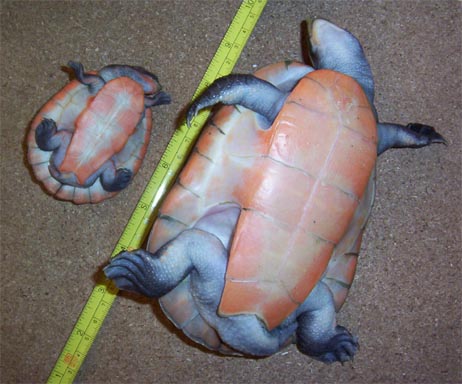The possible negative effects of improper diet concerning the Australasian turtles
[Information retrieved from various personal comments made by Scott Thomson, 2001-2003]
Jan Matiaska and Scott Thomson
 Renal
failure/Kidney defects: Australasian turtles are physiologically incapable
of processing the fat in red meat. Due to a high protein diet and excessive
metabolism, captive specimens tend to have their kidneys enlarged. The symptomatic
changes to kidneys and liver can also result in pale colour of the organs
and the external surface of kidneys can be cauliflower like in texture.
The Australasian turtles are also incapable of processing salt and this
is another factor that leads to renal failure/kidney problems. Reptiles
have a very short loop of henle in the kidney and this is the area in the
kidney used to extract salt. As such any reptile that is salt tolerant has
to develop secondary means of salt extraction, usually salt glands which
are present in many species but not Chelids. All the Australasian turtles
lack salt glands except for Carettochelys insculpta (the PNG and
the Kakadu forms). Interestingly, its close relative - Carettochelys
(the Daly River form) does not have salt glands. Foods to be avoided:
red meat, mince meat, marine fish (e.g. whitebait), offal. Optimal food
characteristics: low fat, low protein, no additional salt.
Renal
failure/Kidney defects: Australasian turtles are physiologically incapable
of processing the fat in red meat. Due to a high protein diet and excessive
metabolism, captive specimens tend to have their kidneys enlarged. The symptomatic
changes to kidneys and liver can also result in pale colour of the organs
and the external surface of kidneys can be cauliflower like in texture.
The Australasian turtles are also incapable of processing salt and this
is another factor that leads to renal failure/kidney problems. Reptiles
have a very short loop of henle in the kidney and this is the area in the
kidney used to extract salt. As such any reptile that is salt tolerant has
to develop secondary means of salt extraction, usually salt glands which
are present in many species but not Chelids. All the Australasian turtles
lack salt glands except for Carettochelys insculpta (the PNG and
the Kakadu forms). Interestingly, its close relative - Carettochelys
(the Daly River form) does not have salt glands. Foods to be avoided:
red meat, mince meat, marine fish (e.g. whitebait), offal. Optimal food
characteristics: low fat, low protein, no additional salt.
Skeletal defects: Thinning of the long bones, loss of bone material from the shell (and skull in severe cases) abnormal bending of long bones and also pelvic bones. These are all signs of calcium/phosphorus imbalance.
Plastron/Carapace defects: High protein results in rapid growth. This causes the center of the scute to grow rapidly giving a pyramid shape to the scute which is filled by the underlying bone. In Chelodina longicollis both rapid growth of the anterior plastron and flattening of the shell occur. In Emydura macquarii macquarii it causes excessive flaring of the posterior marginals which become very thin and curl upwards. "Chelodina longicollis is naturally a brown colour but due to the extreme proximity of the growth rings they appear black." (Scott Thomson, 2003, pers. comm.) Therefore, if a specimen of this species is black in colour, it is on a correct diet. If it is brown, it has grown too fast. The photo above shows two specimens of Emydura subglobosa subglobosa, both of the same age and coming from the same clutch. As of January 2004, the specimens are 3 years old. They both have been kept under the same conditions, the same temperature, and the same water quality. The only difference has been the type and the amount of food they have been given. While the smaller specimen is given food every third day with low fat and low protein, the bigger specimen is given food every other day with low fat but high protein. The difference is striking: 7.5 cm CL vs. 15 cm CL. The smaller specimen is of size which is attained by the wild specimens of the same species of the same age in their natural habitat. The other one is twice as big and only time will tell how this rapid growth rate is will affect its health. Carapace/plastron can also become soft. This is caused due to lack of calcium and/or vitamin D3. UV light is needed by all turtles for the synthesis of vitamin D3. This is used in the binding of calcium during the formation of carapace, plastron and bones among other things. Hence turtles, which have high bone density, have a significant requirement for calcium and D3 which.
Neurological problems: Lack of thiamine may cause neurological problems. The good source of an enzyme called thiaminase is fish. If fish has been frozen, the thiamine is destroyed. It can be easily fixed by supplementation or balancing the diet with other products. Marine fish, marine mussels and shrimps must be soaked for a few hours to remove excess salt.
